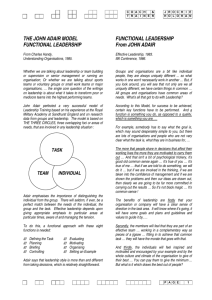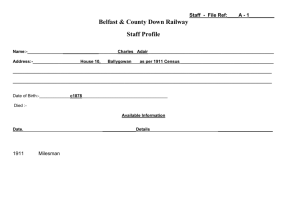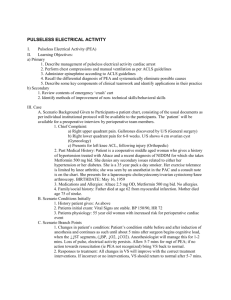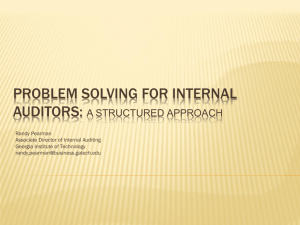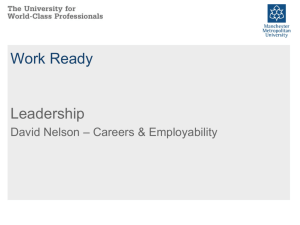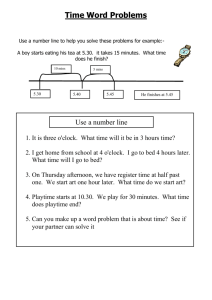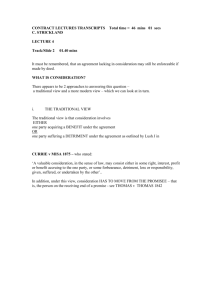M&L P4 FSG 004 2.1.2 Leading effective teams BM120206
advertisement
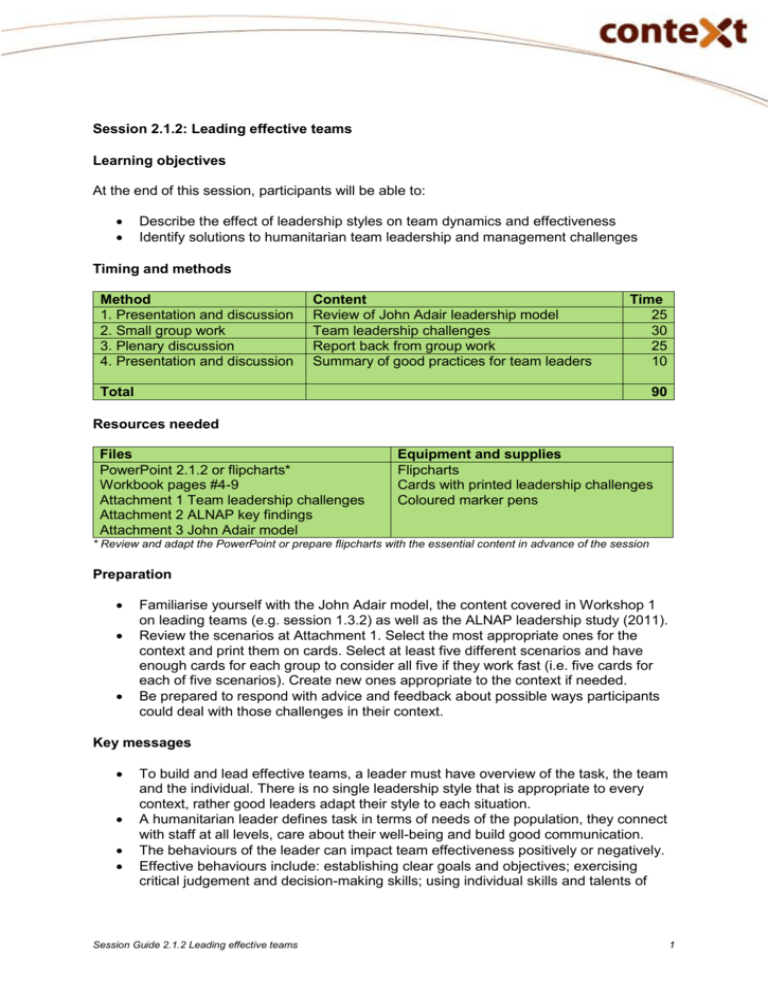
Session 2.1.2: Leading effective teams Learning objectives At the end of this session, participants will be able to: Describe the effect of leadership styles on team dynamics and effectiveness Identify solutions to humanitarian team leadership and management challenges Timing and methods Method 1. Presentation and discussion 2. Small group work 3. Plenary discussion 4. Presentation and discussion Content Review of John Adair leadership model Team leadership challenges Report back from group work Summary of good practices for team leaders Time 25 30 25 10 Total 90 Resources needed Files PowerPoint 2.1.2 or flipcharts* Workbook pages #4-9 Attachment 1 Team leadership challenges Attachment 2 ALNAP key findings Attachment 3 John Adair model Equipment and supplies Flipcharts Cards with printed leadership challenges Coloured marker pens * Review and adapt the PowerPoint or prepare flipcharts with the essential content in advance of the session Preparation Familiarise yourself with the John Adair model, the content covered in Workshop 1 on leading teams (e.g. session 1.3.2) as well as the ALNAP leadership study (2011). Review the scenarios at Attachment 1. Select the most appropriate ones for the context and print them on cards. Select at least five different scenarios and have enough cards for each group to consider all five if they work fast (i.e. five cards for each of five scenarios). Create new ones appropriate to the context if needed. Be prepared to respond with advice and feedback about possible ways participants could deal with those challenges in their context. Key messages To build and lead effective teams, a leader must have overview of the task, the team and the individual. There is no single leadership style that is appropriate to every context, rather good leaders adapt their style to each situation. A humanitarian leader defines task in terms of needs of the population, they connect with staff at all levels, care about their well-being and build good communication. The behaviours of the leader can impact team effectiveness positively or negatively. Effective behaviours include: establishing clear goals and objectives; exercising critical judgement and decision-making skills; using individual skills and talents of Session Guide 2.1.2 Leading effective teams 1 team members; communicating and consulting; listening and observing; encouraging and motivating; delegating tasks and investing in developing people. Instructions Activity 1: Presentation and discussion – Review of John Adair and leadership styles 25 mins ‘Bad leader/good leader’ exercise 5-10 mins Open the session with the ‘bad leader/good leader’ exercise. This is a powerful way of highlighting the impact a leader has on team effectiveness. Note that it can go on for a long time, as people get very excited by it. Make sure you keep it fast and short - maximum 10 minutes. Ask participants to close their eyes and try to remember the worst leader they ever had Wait 30 seconds and then invite participants to call out one word which describes that leader. Write the words on a flipchart Next, ask participants to call out one word which describes how that leader made them feel. Write those words on a flipchart Next, ask participants to close their eyes again and remember the best leader they ever had Wait 30 seconds and then ask participants to call out one word which describes that leader. Write the words on a flipchart Finally ask participants to call out one word which describes how that boss made them feel. Write those words on a flipchart It is likely that participants will describe the demotivating and demoralising effect of a bad leader, and the empowering and motivating effect of a good leader. Emphasise that the leadership styles and skills of the leader play a crucial role in determining team effectiveness. Link the discussion back to the leadership competencies headings 2-5 mins Note the session objectives 1 min Highlight the following competency headings in relation to the points which emerged about a good leader: Motivating and influencing Critical judgement Self-awareness At the end of this session, participants will be able to: Describe the effect of leadership styles on team dynamics and effectiveness Identify solutions to humanitarian team leadership and management challenges Session Guide 2.1.2 Leading effective teams 2 Build the link between this session and Workshop 1 5 mins Briefly remind participants about the John Adair model 2 mins Introduce the concept of adapting leadership styles 5 mins Ask participants to recall what they learned about leading teams from Workshop 1. Note: If you have video of the ‘sheep and the shepherd’ activity from Workshop 1, play this now as a reminder. The following questions might help: What did you learn in Workshop 1 about how to lead a team effectively? How have you put what you learned in the ‘sheep and shepherd’ game into practice? What do you remember about the John Adair model of actioncentred learning? Show Slide #2 (or a flipchart) with the John Adair ‘Task, Team and Individual’ model and summarise the key points from Workshop 1: To build and lead effective teams, a leader must have overview of the task, the team and the individual An effective leader will set the structure, tasks and expectations about behaviour, and will then nurture the team and its members to realise their full potential Show Slide #3 and explain that: There is no single leadership style that is appropriate to every context. It must be adapted to the situation. What is needed depends on the complexity of the task, the skills of the team members and the urgency of the situation A good leader in one situation is not necessarily a good leader in another, but being able to adapt and apply different leadership styles and approaches can make a leader more versatile and more effective in different contexts If time permits, briefly discuss different types of leadership styles and how they might apply in different humanitarian contexts. Activity 2: Small group work – team leadership challenges 30 mins Small group exercise ‘team leader challenges’ 30 mins Ask participants to work in their buddy groups. Give participants one scenario on a printed card (see attachment) to focus on in depth for 20 minutes. Show Slide #4 and explain that: You will be working in small groups for the next 30 minutes to review some management leadership challenges This is an emergency situation and you need to be able to deal with many problems at once in a high-pressure environment Assume that you are the team leader - from the perspective of the team leader, how will you deal with this scenario? Record your conclusions on a flipchart. Share any similar experiences that you have had After 20 minutes, give them up to four more scenarios for them to deal with at once, to give them a sense of dealing with team issues under pressure. Session Guide 2.1.2 Leading effective teams 3 Remind groups to always use the humanitarian imperative, humanitarian principles and agency mandates as guide for decisionmaking, as well as the ideas about balancing team, task and individual. Activity 3: Plenary discussion – Report back from group work 25 mins Report back to plenary 25 mins In plenary, ask each groups to report back on the one scenario they focused on first. Ask: How did you consider the ‘team, task and individual’ needs? How did this affect your leadership decisions? How did pressure affect your decision-making? Discuss any key themes emerging from the group reports about challenges and solutions for leading teams under pressure. Activity 5: Presentation and discussion – Summary of good practices for team leaders 20 mins Discuss good practices for leading effective teams 15 mins Show Slide #5 or flipchart and refer to workbook page #8 to share the good practices for leading effective teams described below. Clarify goals and roles Use individual skills and talents Communicate and consult Listen and observe Encourage and motivate Review and learn lessons Delegate tasks and develop people Remember the importance of team meetings Recognise and acknowledge what is being done well Ask if there are any additional ideas we should add. Highlight where these practices were important in the group work scenarios and support points with any relevant examples from the ALNAP study (Attachment 2). If participants are not already familiar with ALNAP, explain the acronym – Active Learning Network for Accountability and Performance in the humanitarian sector. Optional, if time: Explain task vs. relationship behaviours 3 mins Ask participants: How do you make time for these in humanitarian response? Explain that: There are two general kinds of team leader behaviours: o Task behaviours (product) – these focus on goal accomplishment and help group members achieve their objectives o Relationship (process) behaviours – focus on team Session Guide 2.1.2 Leading effective teams 4 members feeling comfortable with themselves, each other and the situation in which they find themselves In an emergency, there is a tendency to focus on task behaviours, but the leader needs to ensure they are giving attention to task and relationship behaviours Leaders need to determine which mix of the two behaviours will bring out the best in the team. See workbook page #9 for more information. Conclude with key learning points 2 mins Refer back to the competency framework and reinforce the importance of: being aware of one’s own leadership skills and qualities and the impact that this will have on team effectiveness considering the needs of the task, team and individual adapting your leadership style accordingly. Session Guide 2.1.2 Leading effective teams 5 Attachments Attachment 1: Small group work management and leadership scenarios Scenario 1: There is no food available at a field site where your staff are working, so at the beginning of the programme it was decided to give staff working there an allowance to buy food in town before travelling to the field site (5km away). Now the project vehicles leave late every morning because of the time it takes to organise buying lunch, and the number of staff has increased, making the cost of lunch allowances unacceptably high. There is also now food available at the field site, but your staff prefer the food from town. How do you as team leader resolve this? How do you ensure people agree with your decision? Scenario 2: You are an incoming manager for a cash-for-work programme. The project proposal listed a number of types of activities that could be undertaken by communities for CFW. You discover that the team implementing the project has misunderstood the proposal and informed communities that they could only do CFW for one of the activities in the list. You realise that communities could have suggested their own projects and were given no choice. A proper consultation process was not undertaken. How would you resolve this with your team and the community? Scenario 3: An issue has arisen in your team about communications access. You are the team leader. The organisation’s policy says that only key staff are issued with mobile phones and credit. They sometimes use these to call family – but using their own credit. There have been some comments (not yet complaints) from other staff. How is this managed so that resentment does not build? Scenario 4: In the project area where you work, local cultural norms do not allow mixed sex households if the occupants are not family. Incoming staff arriving (a mixture of relocated national and international staff) do not feel comfortable with single sex households for safety reasons and prefer mixed housing. Local national staff members feel that mixed households would not be appropriate. As team leader, how do you address this situation? Scenario 5: You are leading a mobile medical team composed entirely of new arrivals to the field location. You are the only one with any real experience and knowledge of what you are doing; however, you need to have your team at full capacity very quickly. What style of leadership do you use in this situation? How do you build up the others’ capacity? Scenario 6: A new international staff member is due to arrive to work in your team. You learn from a staff member that the current team is very unhappy at this news as several have worked with this person before and there were ‘difficulties’. People feel so strongly about this that you are told that they will refuse to work with this team member and will go on strike. As team leader, what would you do to resolve this situation? What options are there? Scenario 7: You are a team leader in an earthquake response. The plastic sheeting you had ordered arrives after a 10-day delivery time. On arrival, it is found to be substandard. Logisticians and lorry drivers are all shouting at you about this. What would you do? What would affect your decision? Scenario 8: You are deployed as a specialist to help to develop a programme. Strong opinions as to the direction of the programme are expressed by the team, many of which you agree with. The Country Manager disagrees but is unable to give – in your opinion – coherent reasons for this disagreement. How does this make you feel? What would you do? Session Guide 2.1.2 Leading effective teams 6 Scenario 9: You are working for six weeks in the acute phase of an emergency. Within the space of one week, your manager and all the other senior staff leave and fresh energetic ones arrive. What would you expect the problems to be? How can you best ensure that the inevitable changes to work practices are managed effectively? Scenario 10: You are deployed to a humanitarian programme and the coordinator goes off sick for several weeks. You have to take on the coordination role as well as your own job. Apart from a bigger workload, this extra responsibility makes you feel anxious, as you are now responsible for security and team welfare and you are concerned that some team members are behaving in a way that could undermine your agency’s credibility. How might your anxiety become obvious? What could you do? Scenario 11: There has been some confusion about the budget in your project, and two of your staff have each made different commitments to project participants on the assumption there was a budget to cover it – however, there is not enough budget to cover both commitments. How will you resolve this? Attachment 2: ALNAP Leadership study key findings and examples from: Leadership in Action: Leading effectively in humanitarian operations, Margie Buchanan-Smith with Kim Scriven, ALNAP, 2011 Good leaders translate humanitarian values into behaviours: o ‘I put myself in the shoes of the affected population. Whenever I go into [a situation like this] I try to see it from the lens of the survivor – what kind of assistance do they want – and thinking ahead, so it’s not just bags of rice but is it really working from their perspective of what’s needed? We need to have a dialogue with them and listen.’ o In relation to Adair’s three circles model of leadership, this means defining task needs clearly in terms of the affected population. The relationship between a leader and their staff is important: o ‘If staff feel you care for them, they are willing to work for you’ was the clear message from a number of interviewees. The human qualities of being able to connect with staff of all levels, from the senior management team to drivers and guards, so that they feel they have a personal relationship with the ‘leader’, and caring for their well-being were noted and cherished. o This is the circle that relates to ‘individual needs’ in Adair’s model. The clear message is that communication and relational skills are critical, to motivate and inspire staff and peers, the ‘followers’, and to bring people with you. They relate to two of the circles in Adair’s model of leadership: group maintenance and individual needs. Good leaders actively work to build a strong team through choosing team members, leading by example and mentoring: o ‘Many leaders inherited rather than chose the team that they worked with and that supported them at the outset. Over time, however, many of them were able to choose and build the kind of team that they wanted. In the words of one of our case study leaders: ‘if you haven’t got something, you have to build a team. A good leader recognises where his or her gaps are and calls on others to fill those gaps. No one person can be a humanitarian leader’. Session Guide 2.1.2 Leading effective teams 7 A good leader is also a good manager: o ‘A common refrain is that effective leaders are rarely good managers. Individuals who have visionary and strategic skills lack the skills to carry out more detailed and routine management tasks; they enjoy the big picture but get bored with the detail. More than half of our case study leaders contradicted this view. They combined an eye for detail with the ability to engage with the bigger picture’. Attachment 3 John Adair Action-Centred Leadership model – recap of content from Workshop 1 The three parts of Adair's Action-Centred Leadership model are commonly represented by three overlapping circles, which is a trademark belonging to John Adair, and used here with his permission. Adair's famous 'three circles' model is one of the most recognisable and iconic symbols within management theory. When you refer to this diagram for teaching and training purposes, please attribute it to John Adair, and help preserve the integrity and origins of this excellent model. When leading a team, you should focus on: achieving the task managing the team or group managing individuals Your responsibilities as a manager for achieving the task are: identify aims and vision for the group, purpose, and direction - define the activity (the task) identify resources, people, processes, systems and tools (inc. financials, communications, IT) create the plan to achieve the task - deliverables, measures, timescales, strategy and tactics establish responsibilities, objectives, accountabilities and measures, by agreement and delegation set standards, quality, time and reporting parameters control and maintain activities against parameters Session Guide 2.1.2 Leading effective teams 8 monitor and maintain overall performance against plan report on progress towards the group's aim review, re-assess, adjust plan, methods and targets as necessary Your responsibilities as a manager for the group are: establish, agree and communicate standards of performance and behaviour establish style, culture, approach of the group - soft skill elements monitor and maintain discipline, ethics, integrity and focus on objectives anticipate and resolve group conflict, struggles or disagreements assess and change as necessary the balance and composition of the group develop team-working, cooperation, morale and team-spirit develop the collective maturity and capability of the group - progressively increase group freedom and authority encourage the team towards objectives and aims - motivate the group and provide a collective sense of purpose identify, develop and agree team- and project-leadership roles within group enable, facilitate and ensure effective internal and external group communications identify and meet group training needs give feedback to the group on overall progress; consult with, and seek feedback and input from the group Your responsibilities as a manager for each individual are: understand the team members as individuals - personality, skills, strengths, needs, aims and fears assist and support individuals - plans, problems, challenges, highs and lows identify and agree appropriate individual responsibilities and objectives give recognition and praise to individuals - acknowledge effort and good work where appropriate, reward individuals with extra responsibility, advancement and status identify, develop and use each individual's capabilities and strengths train and develop individual team members develop individual freedom and authority Importantly as well, Adair set out these core functions of leadership and says they are vital to the Action-Centred Leadership model: Planning - seeking information, defining tasks, setting aims Initiating - briefing, task allocation, setting standards Controlling - maintaining standards, ensuring progress, ongoing decision-making Supporting - individuals' contributions, encouraging, team spirit, reconciling, morale Informing - clarifying tasks and plans, updating, receiving feedback and interpreting Evaluating - feasibility of ideas, performance, enabling self assessment The Action-Centred Leadership model therefore does not stand alone; it must be part of an integrated approach to managing and leading, and which should include a strong emphasis on applying these principles through training. More information available via John Adair's website: http://www.johnadair.co.uk/ Session Guide 2.1.2 Leading effective teams 9
